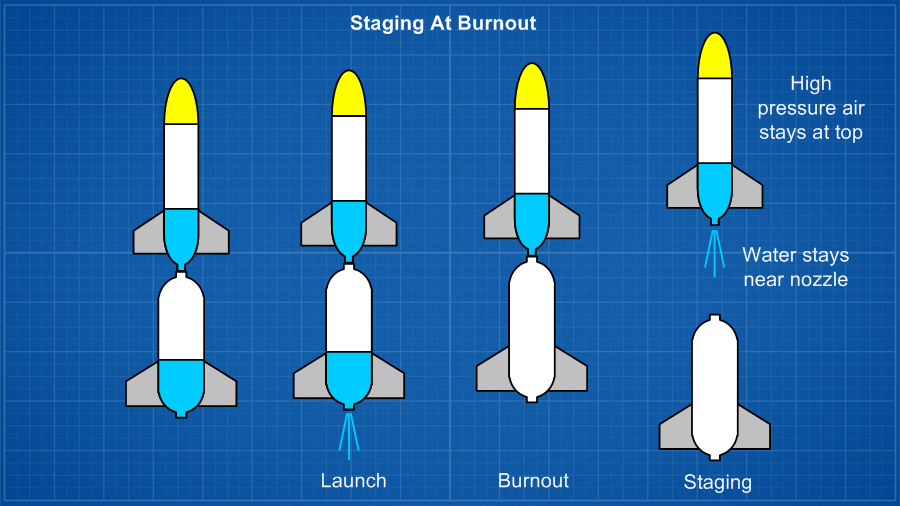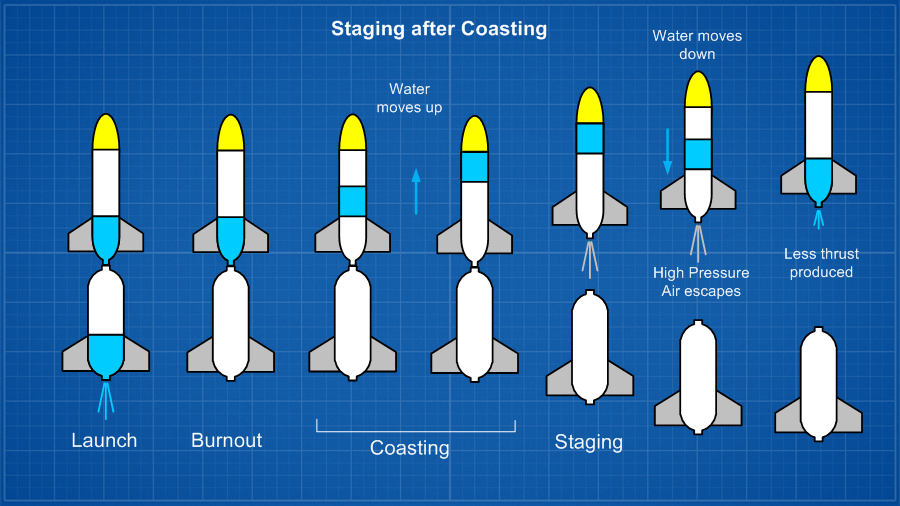| Date: | 12th March 2017 |
| Location: | Whalan Reserve, Australia |
| Conditions: | Mostly Sunny, light breeze, 28C |
| Members: | PK, John K and GK |
Following on from the gravity experiments we did a while back (day 45, day 85, day 136), today we have a look at how liquids behave during flight. There are a number of reasons you may want to know what liquids do if for instance you are flying multi-stage water rockets, or multi-stage hybrid rockets with liquid nitrous oxide, use water as nosecone ballast or even chemical based deployment mechanisms such as vinegar and baking soda.
We filled a couple of T8 FTC tubes with liquids and plugged each end with a bottle cap and used plumbing tape as a seal. The ends were then fitted with the FTC end caps that came with the FTC when we bought it. These end caps help hold the FTC against the bottle caps for a good seal.
One tube is half filled with water and a some food colouring with the other half is just air. The second tube is half filled with water with the other half filled with baby oil. We used baby oil as it is clear and has lower density (0.83) than say vegetable oil (0.92). The clear colour of baby oil also gives better contrast against the coloured water.
Both tubes are mounted vertically between a couple of 3D printed disks and 3 wooden dowels are used as spacers to keep everything together. This then fits inside a nosecone fairing.
We 3D printed a camera bracket that holds the #16 HD V3 808 camera sideways and offsets the camera about 90mm from the tubes. This was determined to be the closest we could get the camera and still achieve reasonable focus with the entire payload in view. We cut out the side of the nosecone fairing so that we got a clear view of the tubes. We also wanted the rest of the fairing to be clear so that you could see the horizon in the same view.
The camera bracket was attached to the disks with double sided tape so there was some give for when the rocket landed. We didn't want the bracket snapping off.
We decided to put the experiment payload above the parachute bay so that when the parachute ejected it wouldn't interfere with the camera bracket.
We used the Axion G6 rocket to boost this experiment as the payload with the parachute mechanism is fairly heavy. We set the deployment timer delay to release the parachute well after apogee so that we could watch the liquid as the rocket passed through apogee in near-Zero G. We launched the rocket at 205psi with 1.5L of water and no foam to get maximum acceleration off the pad.
The rocket flew well and only slightly angled off the pad in the direction where the camera was. The drag of the camera and bracket was partially offset by the weight of the liquid on the other side of the rocket.
The rocket landed well and the camera bracket popped off as designed without damage.
For flight #2 we re-attached the camera bracket and launched the rocket again. This time the pressure was slightly higher at 210psi. The flight was very similar to the first and again the rocket flew and landed well.
Water / Air
Looking at the video of the two tubes, in the tube on the right you can clearly see the water move up shortly after burnout as would be expected because of the drag on the rocket. As the rocket continues to apogee and beyond the water remains in the top portion of the tube until the parachute opens.
Additionally you can also see that the shape of the meniscus also changes from the time the rocket is on the ground to when it is near Zero-G.
Water / Oil
The left tube is a little more interesting. Just like the water in right tube we would have expected the oil and water to also switch completely after burnout with the lower density oil on the bottom. Instead we see 5 distinct layers appear. Oil-water-oil-water-oil. We suspect that midway through the switch the rocket approached zero-G and so there was little incentive for the lower density oil to continue floating towards the bottom below the water, and so that large oil "bubbles" just stayed where they were between the layers of water.
If you look closely enough you can also see bubbles of water floating in the middle oil layer. These bubbles are not floating towards either end of the tube again showing that the rocket is in near zero-G.
If we look at a 2 stage rocket that stages immediately on burnout of the first stage, then there is no problem as the water stays down against the nozzle in the sustainer with the high pressure air above it.

If we consider a second scenario where we let the rocket coast for a while after burnout before staging it. From this experiment we can see that water in the second stage can float up and exchange places with the high pressure air. If the 2nd stage is then released some of the compressed air will escape first before the rocket starts accelerating forcing the water back down towards the nozzle again. By the time the water reaches the nozzle you have less pressure in the rocket and whole system is less efficient.

| Launch | Details | ||||||||||||||||||||||||
| 1 |
|
||||||||||||||||||||||||
| 2 |
|
||||||||||||||||||||||||
| 3 |
|
||||||||||||||||||||||||
| 4 |
|